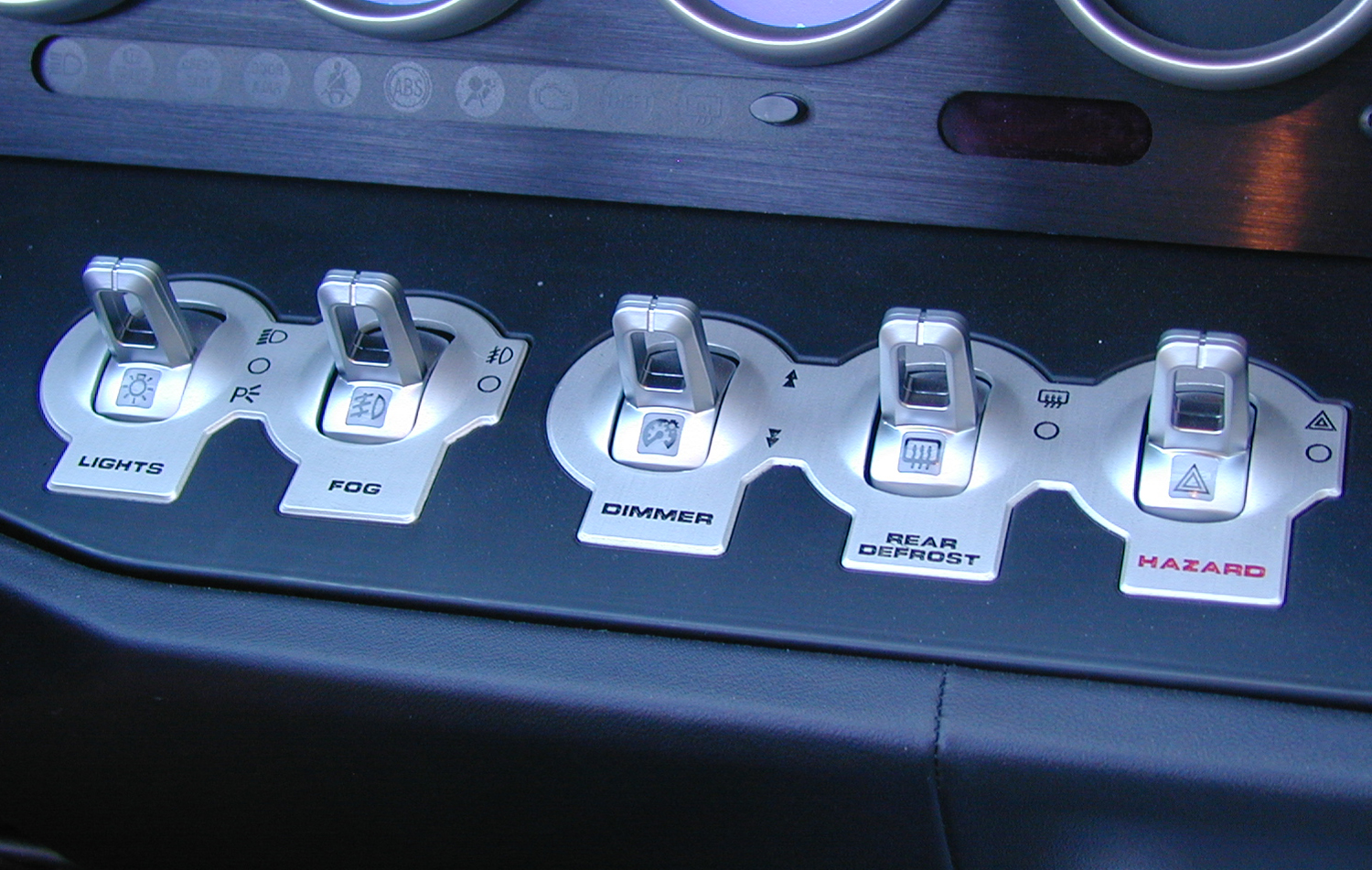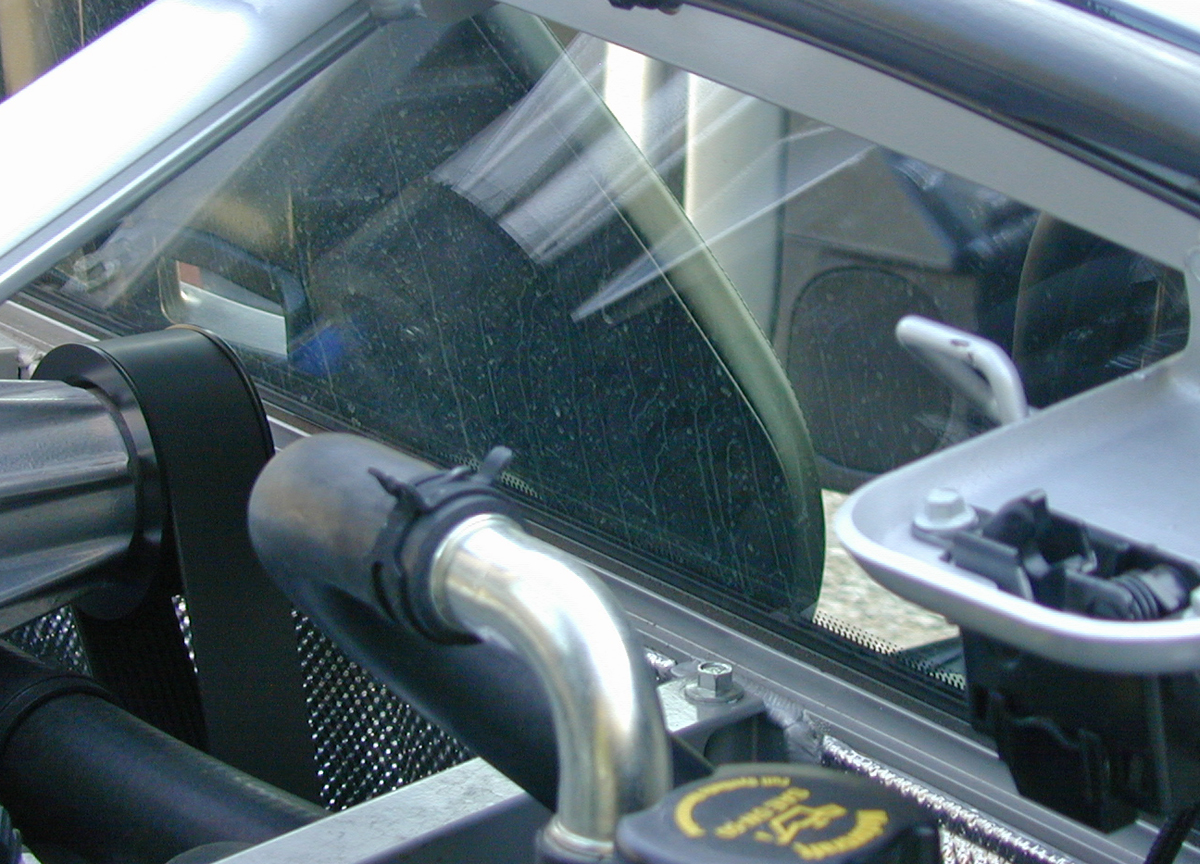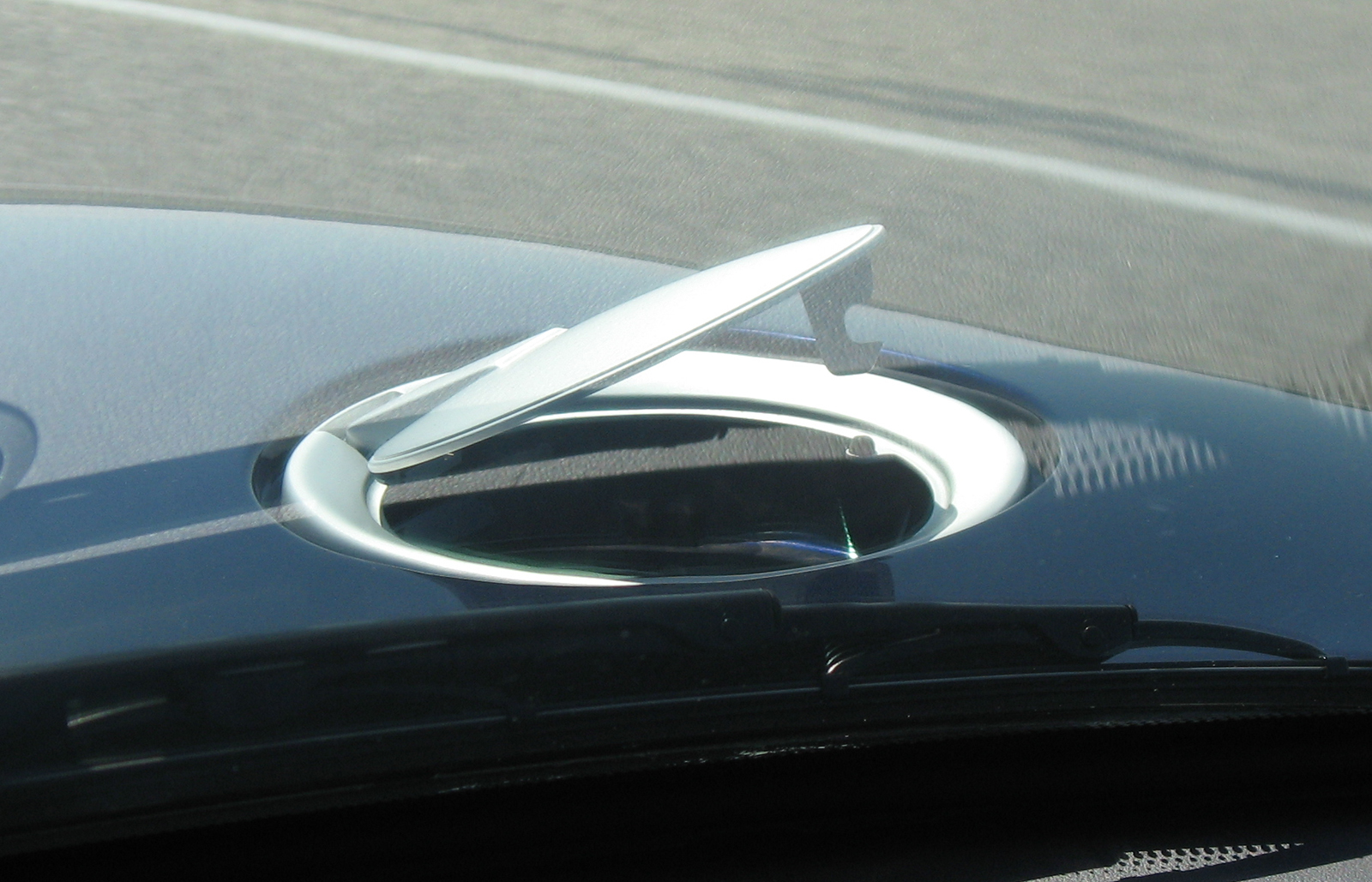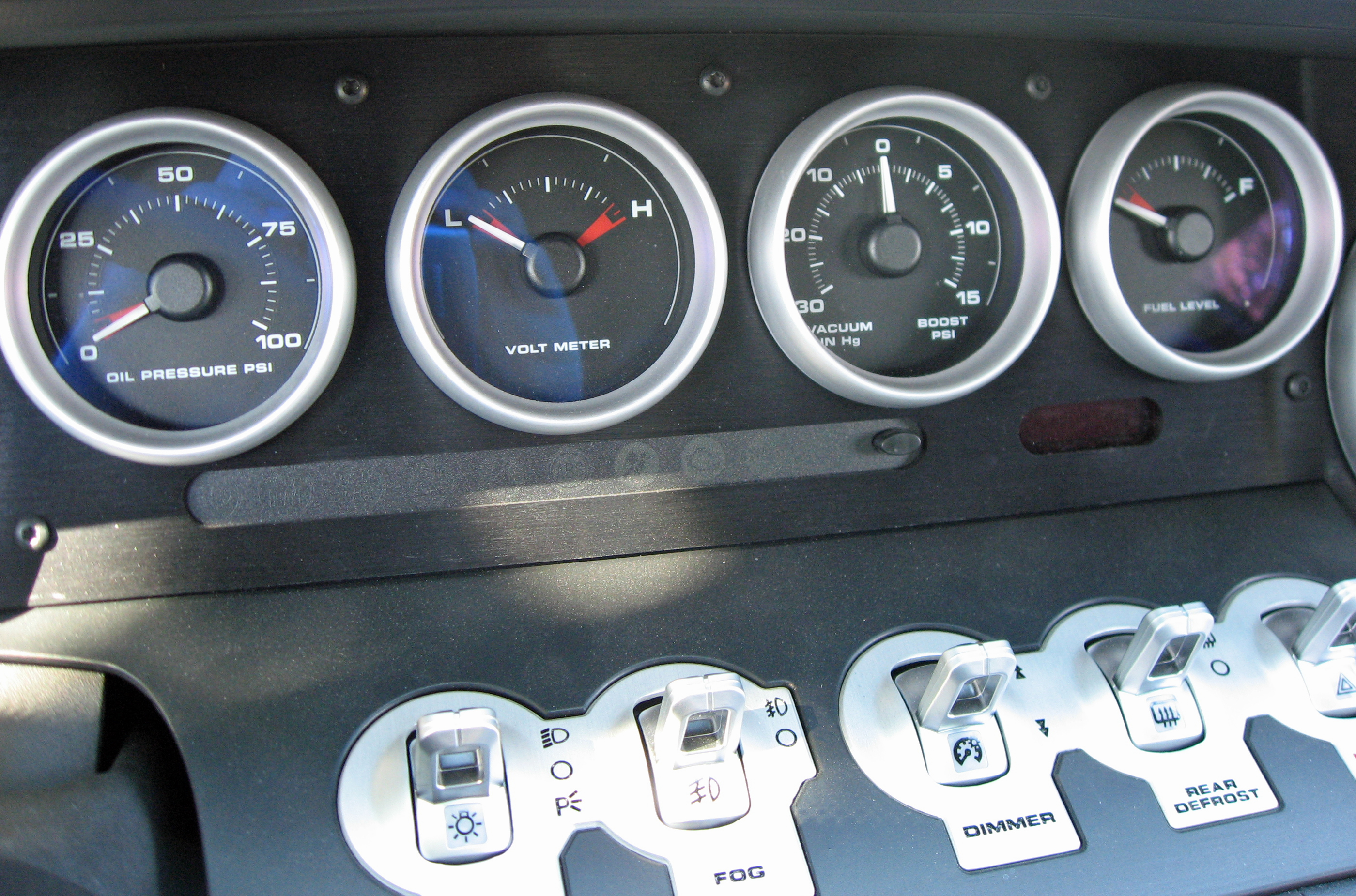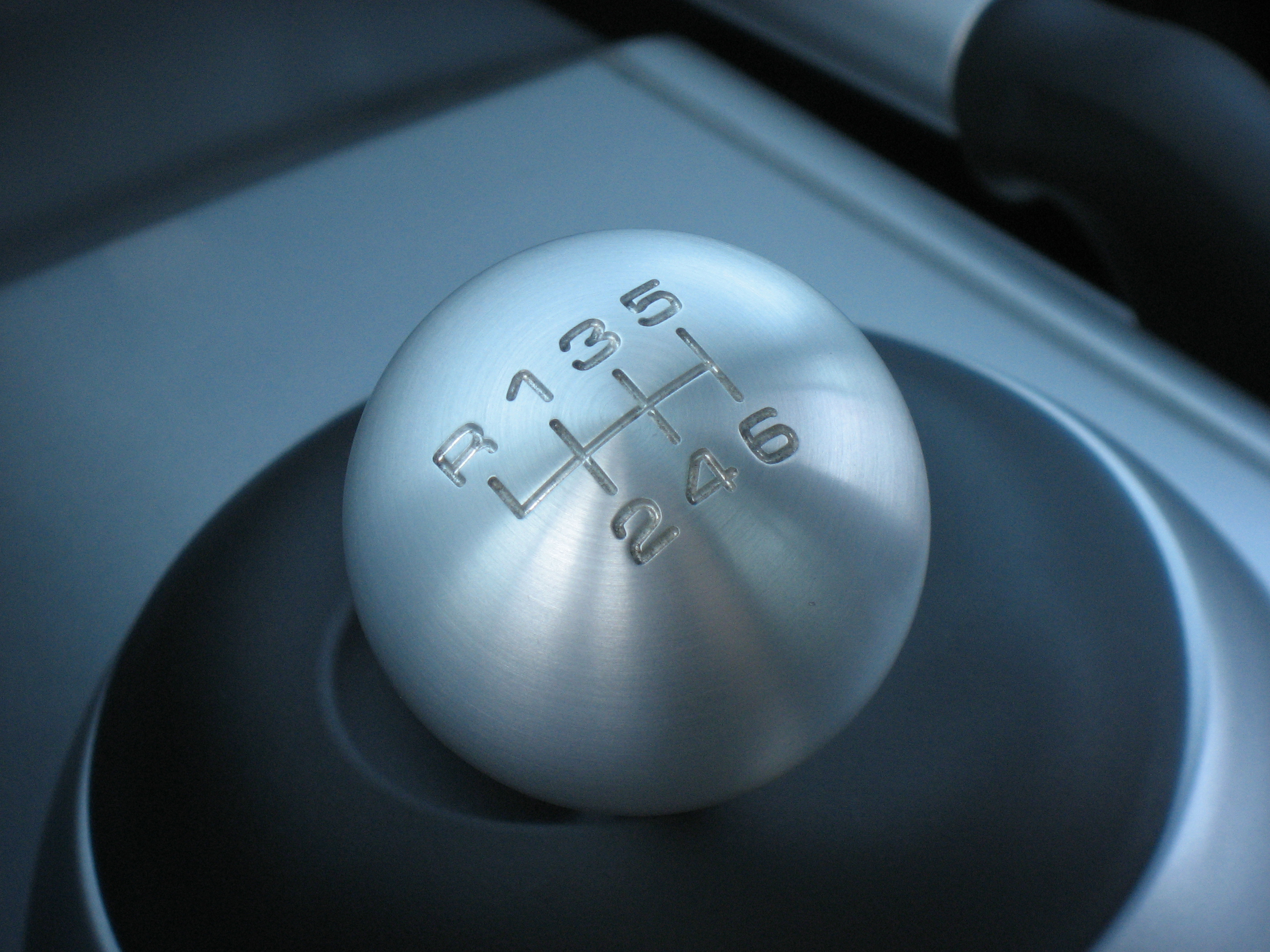After more than a year of ownership my 2005 Ford GT had over 5,700 miles on it. A few quirks had shown up, including gauges that occasionally stopped working and a mid-lite window that required special attention after washing the car. But the GT continued to be one of the best-driving sports cars I’d experienced, with a superb transmission, intuitive steering and the ability to effortlessly devour open road miles.
Ford GT Toggle Switches
September 6, 2006 at 5,082 miles
The Ford GT team used many of the original GT40’s styling cues on the new model, both inside and out. The dash has a long layout with the tachometer front and center. The seats have “holes” to allow better ventilation for when you’re on your 103rd blast down the Mulsanne Straight. And of course the doors extend well into the roof, making it easier to swing them wide and plop down into the seats during those “running” starts…
But I think my favorite part of the GT’s interior has got to be the cool, aircraft-like toggle switches lining the dash. The short explanation is that they offer both form and function, as they are as easy to operate as they are to appreciate from a design perspective.
Taking things a step further than they did in 1966, the new Ford GT’s toggle switches have cool lighted icons to tell you what each one does (if the icons are too cryptic for you the switches are also clearly marked). The only hiccup in the design is not being able to clearly see the left-most switch behind the steering wheel (for the headlights) without craning your head. Of course it’s not too difficult to commit that one piece of information to memory (sort of like remembering to watch your head when exiting the car — but not as painful when it slips your mind).
Ford GT Mid-Lite Glass
September 11, 2006 at 5,120 miles
One of the most troublesome areas to keep clean on the Ford GT is the “mid-lite” glass that separates the cabin from the engine compartment. You might assume this glass should naturally stay clean, as it’s protected by the cabin on the front side and the engine cover (hatch) on the back side. In theory, it shouldn’t be exposed to any dirt-causing activities — unless an engine hose pops or you try to pull an 11-second quarter-mile run while holding a triple scoop ice-cream cone. However, the many cooling vents in the engine cover mean that everytime you wash the GT a percentage of water gets into the engine compartment and splatters on the mid-lite. Of course, it’s easy to miss this little water dance during the washing process, and it’s not until you drive home and see all the water spots (baked on extra crispy from engine heat) that you realize you missed a spot — actually several…
You can try cleaning the window during the wash process, but inevitably more water gets bounced around the engine compartment as soon as you drive the car, so the only way to deal with the issue is to clean everything else, drive car for a few minutes, and then break out the Windex for final wipe-down. It’s also not the easiest panel to reach between the engine cradle and the supercharger.
Yeah, I know — cry me a river.
Ford GT Offers Grand Touring
September 14, 2006 at 5,672 miles
Putting another 500 miles on the Ford GT in the last three days makes one thing abundantly clear — it really is a “GT.” The term “GT” comes from the Italian acronym for “Gran Turismo,” which translates to grand touring. The official definition of a “Grand Touring” car varies depending on whom you ask, but I’ve always thought a “GT” car should possess the ability to travel at a high rate of speed for an extended period of time, all while maintaining a high level of driver/passenger comfort. Using this definition as a guideline, the Ford GT easily lives up to its namesake. The car simply devours superslab (2,000 rpm equals 80 mph in top gear), yet it remains comfortable and relatively quiet at those speeds for extended periods (some types of pavement will get the Goodyear F1 rubber roaring). The best part of the GT’s “GT-ness” shows up when you exit the freeway and jump on a narrow, twisting road like Carmel Valley Ranch Road, just southeast of Carmel…
This route snakes between trees and farmland, and the road itself can be both narrow and bumpy. It’s really more suited to a Mazda Miata or Lotus Elise, but the GT remains surprisingly entertaining despite being oversized and overpowered for this byway. The paths between Los Angeles and Monterey are rife with possibilities — if one is willing to take one or more backroads versus the quick and easy freeways. The GT is happy to oblige either choice (or a mixture of both).
Ford GT Fuel Door
September 18, 2006 at 5,690 miles
On my way back from Laguna Seca I had an interesting experience. After stopping for fuel I drove off and was on the road for a good five minutes before I saw the fuel door flapping in my peripheral vision. I can’t say for certain whether I closed it or not after filling up, but the fact that it took five minutes for the door to start flapping makes me think I did shut it before driving away. One side benefit to the GT’s fuel door placement is that you can see when it is open…
How often do you see a car driving around with the fuel door open and the cap swinging in the breeze? I saw this again on my way to work today, proving most people are oblivious to the issue when it happens. Interestingly, the GT doesn’t have a traditional fuel “cap.” You simply pop the door and slide the fuel nozzle into the spring-loaded cap. When the fuel door popped open it didn’t freak out the engine system — no “Check Engine” light came on, even though that commonly happens when you leave your fuel cap off or loose. Ford says all of its vehicles will eventually use this system. I probably drove like this for 10 minutes, just to see if the engine light would come on. Then I stopped, slammed the cap shut, and got back in. It hasn’t popped up since, so maybe it was user error.
The Ford GT’s gauges occasionally go haywire
Ford GT Gauges Going Wild
September 22, 2006 at 5,710 miles
Talk about a freak-out. I’m driving the GT and I look over and see the gas gauge past empty. A few minutes earlier I’d had just under a quarter of a tank, but now I’m in heavy Friday afternoon traffic and no fuel stations are in sight. I couldn’t believe the car gulped nearly a quarter tank in the 10 minutes since I’d last looked at the gauge (sure, it will go that fast during top speed testing at the Nardo track in Italy, but not in stop-n-go on Pacific Coast Highway)…
Then I happen to glimpse the tach, which was also sitting at zero (bizarre because I had the engine on and was moving at about 20 mph). A glimpse at the speedo, temp and oil pressure dials confirmed the obivous — the gauge cluster was dead. Suddenly I wished I was back to simply driving on fumes. But the car seemed to be running fine, so I kept going and started wondering how hard it would be to schedule a dealer visit while also driving around without any fuel, temp or oil information (not to mention speed or rpm data). Then I had an inspiration. My old 1970 Plymouth GTX often suffered from intermittent gauge failure, but flipping the headlights on always cured the problem — at least for awhile. I reached down, flipped the on GT’s toggle switch for headlights, and BAM! Every gauge jumped to life. That was over 500 miles ago, and the issue hasn’t re-appeared, so maybe it was a fluke (actually, it was obviously a bad ground, but so far not a recurring one). Either way, I love it when my history of driving old Mopars actually aids me in 21st century automotive diagnostics.
The Ford GT’s transmission is one of the best I’ve ever experienced
Ford GT’s Smooth Ricardo 6-Speed Shifter
September 25, 2006 at 5,760 miles
While the inevitable comparison between the Ford GT, the Dodge Viper and the Chevrolet Corvette is unavoidable (heck, we even did our own), there are several areas where the former vastly breaks from the latter two. One of the most obvious differences is in the area of shift quality. The Ford GT uses a Ricardo six-speed transmission, and to put it succintly — this transmission rocks! It offers extremely smooth and precise shifting between gears, and despite the 550 horsepower coursing through it the tranny doesn’t have an “industrial” feel…
It’s one of the most sublime shifters I’ve experienced in any car, let alone a supercar. Clutch pressure is also relatively light, meaning if you can handle a Mustang GT’s clutch you can handle the Ford GT’s third pedal. In contrast, the Corvette and Viper use a Tremec T56 unit, and neither vehicle comes close to offering the GT’s level of precision or sophistication. It’s unfortunate that so few people will ever experience the GT’s shifter and transmission. But with hardly any manuals being sold in the U.S., and with most high-end makers going to electro-hydraulic versions of the manual transmission, there likely won’t be any “three-pedal” manuals around in a few years anyway. Between having a “real” manual and offering no driver aids beyond ABS the GT is a bit of an anachronism. Which is a big part of why I like it so much.

